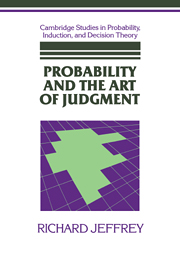Book contents
- Frontmatter
- Contents
- Preface
- 1 Introduction: Radical probabilism (1991)
- 2 Valuation and acceptance of scientific hypotheses (1956)
- 3 Probable knowledge (1968)
- 4 Probability and the art of judgment (1985)
- 5 Bayesianism with a human face (1983)
- 6 Alias Smith and Jones: The testimony of the senses (1987)
- 7 Conditioning, kinematics, and exchangeability (1988)
- 8 Preference among preferences (1974)
- 9 On interpersonal utility theory (1971)
- 10 Remarks on interpersonal utility theory (1974)
- 11 Mises redux (1977)
- 12 Statistical explanation vs. statistical inference (1969)
- 13 New foundations for Bayesian decision theory (1965)
- 14 Frameworks for preference (1974)
- 15 Axiomatizing the logic of decision (1978)
- 16 A note on the kinematics of preference (1977)
4 - Probability and the art of judgment (1985)
Published online by Cambridge University Press: 05 June 2012
- Frontmatter
- Contents
- Preface
- 1 Introduction: Radical probabilism (1991)
- 2 Valuation and acceptance of scientific hypotheses (1956)
- 3 Probable knowledge (1968)
- 4 Probability and the art of judgment (1985)
- 5 Bayesianism with a human face (1983)
- 6 Alias Smith and Jones: The testimony of the senses (1987)
- 7 Conditioning, kinematics, and exchangeability (1988)
- 8 Preference among preferences (1974)
- 9 On interpersonal utility theory (1971)
- 10 Remarks on interpersonal utility theory (1974)
- 11 Mises redux (1977)
- 12 Statistical explanation vs. statistical inference (1969)
- 13 New foundations for Bayesian decision theory (1965)
- 14 Frameworks for preference (1974)
- 15 Axiomatizing the logic of decision (1978)
- 16 A note on the kinematics of preference (1977)
Summary
PROBABILISM
In the middle of the seventeenth century, philosophers and mathematicians floated a new paradigm of judgment that was urged upon the educated public with great success, notably in a prestigious “how to think” book, The Port-Royal Logic (Arnauld 1662), which stayed in print, in numerous editions, for over two centuries. We judge in order to act, and gambling at odds is the paradigm of rational action. (“Anything you do is a gamble!”) That was the new view, in which judgment was thought to concern the desirabilities and probabilities of the possible outcomes of action, and canons for consistency of such judgments were seen as a logic of uncertain expectation. In time (ca. 1920), “The probability of rain is 20 percent” came to be possible as a weather forecast, the point of which is to identify 4:1 as the “betting odds” (ratio of gain to loss) at which the forecaster would think a gamble on rain barely acceptable, e.g., the gamble a farmer makes when he decides to harvest his alfalfa.
Such is probabilism. Radical probabilism adds the “nonfoundational” thought that there is no bedrock of certainty underlying our probabilistic judgments. The 20:80 probability balance between rain and dry need not be founded upon a certainty that the air has a certain describable feel and smell, say, and that when it feels and smells that way it rains just 20 percent of the time.
- Type
- Chapter
- Information
- Probability and the Art of Judgment , pp. 44 - 76Publisher: Cambridge University PressPrint publication year: 1992
- 3
- Cited by



